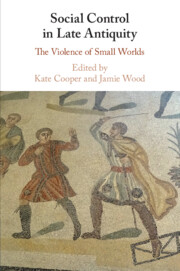Book contents
- Social Control in Late Antiquity
- Social Control in Late Antiquity
- Copyright page
- Contents
- Contributors
- Preface and Acknowledgements
- Abbreviations
- Introduction
- Part I Women and Children First
- Chapter 1 Female Crime and Female Confinement in Late Antiquity
- Chapter 2 Holy Beatings
- Chapter 3 Power, Faith, and Reciprocity in a Slave Society
- Chapter 4 A Predator and a Gentleman
- Part II ‘Slaves, be subject to your masters’
- Part III Knowledge, Power, and Symbolic Violence
- Part IV Vulnerability and Power
- Bibliography
- Index
Chapter 1 - Female Crime and Female Confinement in Late Antiquity
from Part I - Women and Children First
Published online by Cambridge University Press: 18 September 2020
- Social Control in Late Antiquity
- Social Control in Late Antiquity
- Copyright page
- Contents
- Contributors
- Preface and Acknowledgements
- Abbreviations
- Introduction
- Part I Women and Children First
- Chapter 1 Female Crime and Female Confinement in Late Antiquity
- Chapter 2 Holy Beatings
- Chapter 3 Power, Faith, and Reciprocity in a Slave Society
- Chapter 4 A Predator and a Gentleman
- Part II ‘Slaves, be subject to your masters’
- Part III Knowledge, Power, and Symbolic Violence
- Part IV Vulnerability and Power
- Bibliography
- Index
Summary
Although Roman criminal law differentiated between male and female offenders, women were not necessarily treated more leniently than men. Female sexual crime especially could be prosecuted in a visible manner and punished severely. This chapter discusses late antique families’ strategies for evading potentially humiliating public criminal process when it came to addressing the wrongdoing of female family members. Always a possibility in the accusatory criminal system of the Roman world, these strategies of evasion became increasingly formalised during late antiquity with the rise of ecclesiastical mediation. Such extrajudicial redress could result in women’s domestic seclusion. Towards the end of antiquity, female confinement was moved from the extrajudicial to the judicial sphere, with the introduction of the penalty of forced residence in a monastery. While forced residence in a monastery was seen as applicable to both male and female offenders, when applied to women it eased the pressures exerted by Roman law’s interference with intimate family affairs. In this way, the monastery became a locus of intersection between small-scale household-based and large-scale state acts of social control.
- Type
- Chapter
- Information
- Social Control in Late AntiquityThe Violence of Small Worlds, pp. 15 - 38Publisher: Cambridge University PressPrint publication year: 2020



